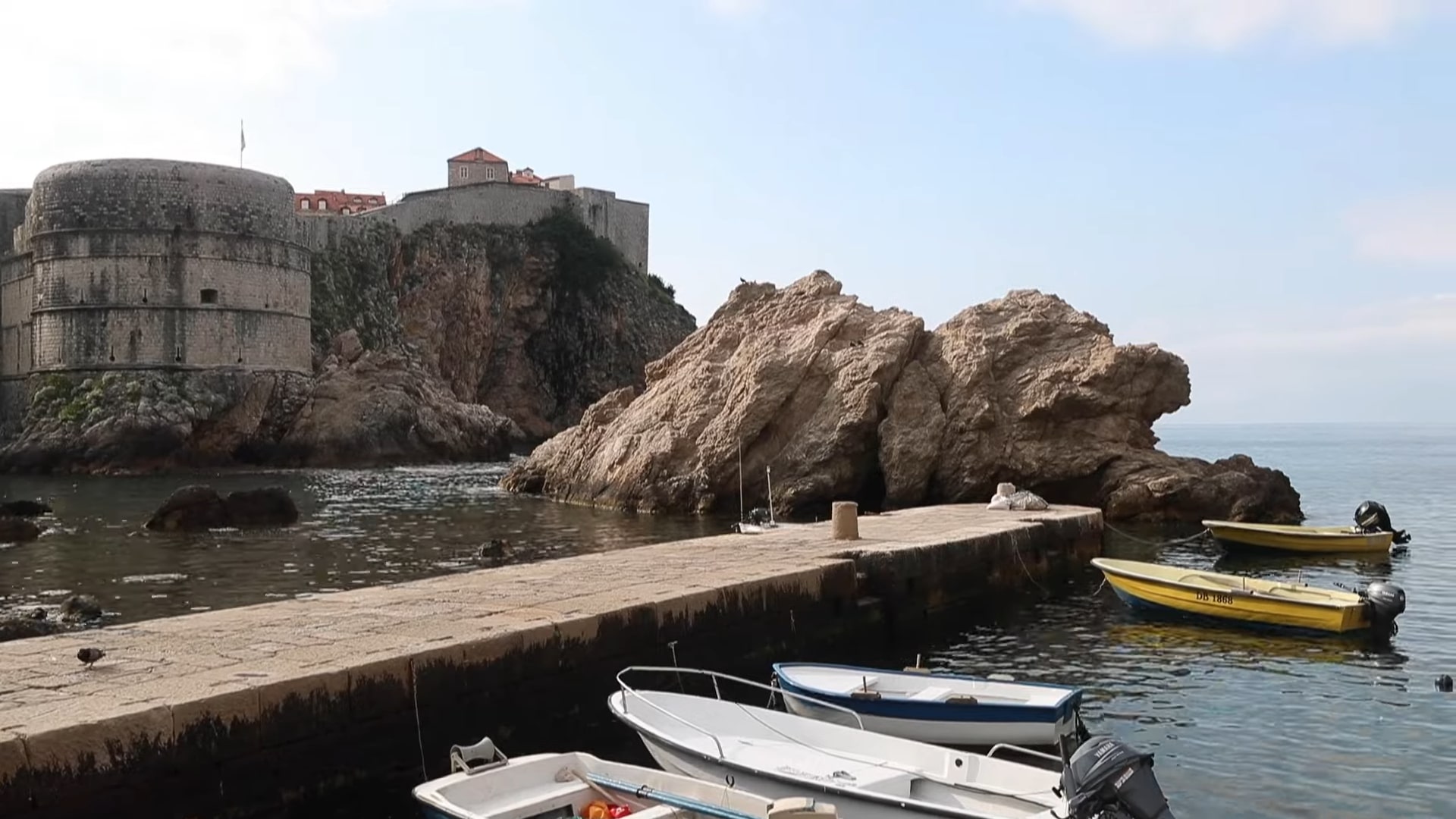Game of Thrones captured audiences worldwide with its stunning visuals and intricate storytelling. It truly is among the TV shows that marked the 21st century.
The series’ commitment to bringing George R.R. Martin’s world to life extended to its choice of filming locations, which played a vital role in creating its immersive settings.
Many of these places are real, attracting tourists and fans eager to experience the magic of Westeros firsthand.
Northern Ireland
View this post on Instagram
Northern Ireland played a significant role in shaping the world of Game of Thrones, serving as the production base for many of the series’ most memorable scenes.
The region’s striking locations brought the drama of Westeros to life, leaving an indelible impression on fans.
- The Dark Hedges: This atmospheric avenue of beech trees became the Kingsroad, the pathway to King’s Landing. Its haunting beauty made it one of the most photographed sites among fans.
- Ballintoy Harbour: Transformed into Lordsport in the Iron Islands, this coastal village provided the setting for Theon Greyjoy’s return to his ancestral home.
Other iconic locations include:
- Castle Ward: This 18th-century estate served as the backdrop for Winterfell in later episodes. Its distinctive architecture and surroundings were crucial in depicting the Stark stronghold.
- Tollymore Forest Park: Featured in the show’s opening episode, this lush forest was the setting for the discovery of the direwolf pups and several haunting Night’s Watch moments.
- Glens of Antrim: These valleys and cliffs provided a dramatic stage for Dothraki Sea scenes and intense battles.
Additionally, fans can visit the Game of Thrones Studio Tour in Banbridge, where they can immerse themselves in the behind-the-scenes magic of the series.
This tour showcases props, costumes, and sets used during filming, making it a must-see for enthusiasts.
Croatia

Croatia’s striking historical architecture and stunning coastal locations made it a perfect backdrop for many iconic scenes in Game of Thrones.
The country’s ancient cities and dramatic settings were instrumental in bringing Westeros to life, making Croatia a sought-after destination for fans.
- Dubrovnik Old Town: Known for its medieval walls and intricate streets, Dubrovnik transformed into King’s Landing, hosting key moments of political intrigue and epic battles.
- Fort Lovrijenac: Overlooking the sea, this fortress became the site of the Battle of Blackwater Bay, adding tension and scale to one of the show’s most significant clashes.
- Jesuit Staircase: This baroque staircase in Dubrovnik gained fame as the setting for Cersei’s infamous Walk of Shame, a scene etched into the memory of fans.
Additional locations include:
- Diocletian’s Palace (Split): This Roman-era structure became the setting for Meereen, the city where Daenerys Targaryen consolidated her rule.
- Šibenik: This coastal city served as the Free City of Braavos. Its streets and buildings, particularly those used for the Iron Bank.
Croatia’s combination of ancient structures and coastal settings created a visual feast for viewers, blending the past with the fantasy of Westeros. For fans, walking through these real-world locations offers a chance to feel part of the series’ magic.
Iceland
Iceland served as an ideal setting for Game of Thrones, providing the frozen, otherworldly landscapes needed to depict the harsh environment of the North and the territories beyond the Wall.
Its dramatic scenery created an unforgettable backdrop for many of the series’ most iconic moments.
- Vatnajökull National Park: This vast expanse of ice and snow became the embodiment of the unknown dangers lying north of the Wall.
- Grjótagjá Lava Cave: This small geothermal cave became the setting for Jon Snow and Ygritte’s intimate moment in Season 3.
- Kirkjufell Mountain: This visually striking mountain made its appearance in Season 7, where it was shown as “the mountain shaped like an arrowhead.”
Additional locations featured in the show include:
- Hverfjall Volcano: Its dramatic crater was used to enhance the starkness of the North.
- Mýrdalsjökull Glacier: This glacier added to the depiction of the icy terrain where the White Walkers roamed.
Iceland’s glaciers, lava fields, and other natural wonders provided a dynamic and imposing setting for the show’s northern regions.
The country’s ability to portray both beauty and harshness made it an essential part of the Game of Thrones experience, inspiring countless fans to visit its iconic sites.
Spain
Spain played a vital role in bringing the world of Game of Thrones to life, offering a variety of stunning locations that helped create some of the series’ most iconic settings.
Its historical architecture and dramatic terrains made it a natural choice for the show’s producers, and the country featured prominently across multiple seasons.
- Alcázar of Seville: This majestic palace served as the Water Gardens of Dorne, home to House Martell.
- Its intricate design, lush gardens, and reflective pools added elegance and intrigue to the scenes set in Dorne.
- Bardenas Reales Desert: This stark and otherworldly landscape was transformed into part of the Dothraki Sea, where Daenerys Targaryen first met the Dothraki tribes.
Other significant locations include:
- Itzurun Beach (Basque Coast): This rugged coastline became Dragonstone, the ancestral seat of House Targaryen.
- Castillo de Almodóvar del Río: This medieval castle brought Highgarden to life, showcasing the wealth and splendor of House Tyrell.
- Roman Bridge of Córdoba: Depicting Volantis’ Long Bridge, this historic structure played a crucial role in capturing the essence of one of Essos’ most powerful cities.
- Plaza de Toros (Osuna): This bullring was transformed into Meereen’s fighting pits, hosting intense gladiatorial battles and Daenerys’ dramatic rescue by her dragons.
View this post on Instagram
Spain’s combination of ancient architecture, diverse terrain, and cinematic versatility made it a cornerstone of Game of Thrones’ production.
These locations remain a magnet for fans eager to walk through the settings of their favorite scenes.
Morocco
Game of Thrones Season 3 being filmed in Morocco. pic.twitter.com/HnTIezlyqI
— Africa Facts Zone (@AfricaFactsZone) April 27, 2022
Morocco provided the perfect setting for the vibrant and complex world of Slaver’s Bay, bringing the bustling cities of Essos to life in Game of Thrones. Its dramatic architecture and storied locations were pivotal in creating an authentic atmosphere for Daenerys Targaryen’s early conquests and her rise to power.
- Essaouira: This historic coastal city was transformed into Astapor, where Daenerys famously acquired the Unsullied, marking a major turning point in her storyline.
- Aït-Ben-Haddou: Known for its ancient ksar (fortified village), this UNESCO World Heritage Site served as Yunkai, the Yellow City, and Pentos.
Other notable aspects include:
- Cinematic History: Morocco has long been a favorite for filmmakers due to its architectural depth and historical resonance.
- Vibrant Culture: The fusion of historic design and bustling marketplaces provided an immersive environment that reflected the complexity of the Slaver’s Bay narrative.
Morocco’s enduring legacy in film, coupled with its role in shaping Essos, continues to draw visitors who wish to step into the world of Game of Thrones and relive its most iconic scenes.
Malta
Malta provided an unforgettable backdrop for the early episodes of Game of Thrones, contributing significantly to the visual identity of the Seven Kingdoms during the show’s first season.
The country’s striking combination of historic architecture and dramatic coastlines brought key moments in Westeros to life, making it a central part of the series’ origins.
- Gozo’s Azure Window: This stunning natural limestone arch, located on the island of Gozo, became the setting for Daenerys Targaryen and Khal Drogo’s wedding.
- Fort Manoel: Situated in the heart of Valletta, this imposing fort was the site of one of the show’s most emotional scenes, the public execution of Ned Stark.
Other notable filming locations in Malta include:
- Mdina Gate: Known as the Silent City, Mdina’s medieval walls doubled as the entrance to King’s Landing. The gate featured in scenes where Ned Stark first arrived in the capital.
- Verdala Palace: This historic palace served as the exterior of Illyrio Mopatis’ mansion, where Daenerys was introduced in the series’ opening episodes.
Malta’s ancient structures, combined with its striking coastal scenery, made it an ideal choice for creating the atmosphere of Game of Thrones. Its role in shaping the visual narrative of the show’s first season continues to draw fans to its shores, eager to experience the world of Westeros firsthand.
Scotland
Scotland provided a significant setting for the pilot episode of Game of Thrones, leaving a lasting impression on the series’ visual style and its connection to medieval history.
The iconic Doune Castle served as the original Winterfell, home to House Stark, with its imposing structure and historical features adding authenticity to the show’s depiction of the North.
Located near Stirling, this historic fortress was chosen for its preserved medieval architecture. Its stone walls, grand hall, and surrounding grounds embodied the Stark family’s ancestral home, setting the tone for Winterfell’s later representations.
- The decision to use Doune Castle provided a tangible link between the fictional world of Westeros and real-world history.
- The castle has since become a popular destination for fans, who visit to experience the halls and grounds where key early scenes were filmed.
Scotland’s influence in the series extends beyond its initial contribution, as its heritage and architecture continue to resonate with those who admire the artistry and effort that brought the world of Westeros to life.
Greece
在 Instagram 查看这篇帖子
Meteora’s towering rock formations and monasteries served as the foundation for the Eyrie’s Sky Cells in Game of Thrones.
These ancient monasteries, perched on sheer cliffs, inspired the depiction of the Vale of Arryn as an isolated and treacherous location.
The precarious positioning of these structures perfectly reflected the themes of seclusion and power.
Their design added tension and intrigue, ideal for scenes involving danger and high-stakes decisions.
Digital enhancements further amplified the mystical qualities of the Eyrie, but the natural grandeur of Meteora remained central to its creation. The connection between these real-world locations and the fictional setting highlights Greece’s contribution to the series.
The Bottom Line
The incredible locations featured in Game of Thrones showcase the effort and vision behind its production.
These places have not only shaped the series’ storytelling but also encouraged fans to experience their beauty firsthand.
The connection between real-world destinations and Westeros ensures that the legacy of the show continues to live on in the hearts of its audience.


